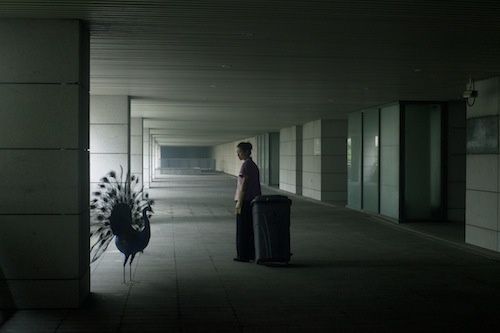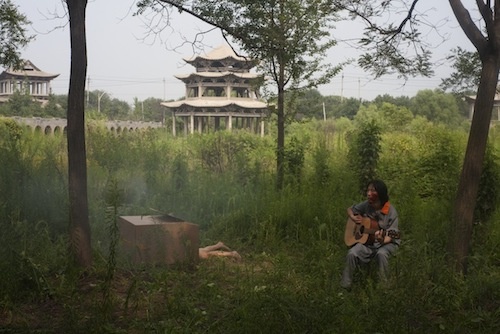“THE MAKING OF A MODERNITY” Cao Fei interviewed by Gavin Wade
by Gavin Wade

Cao Fei, Haze and Fog, production still, 2013
Courtesy of Eastside Projects, Birmingham; and Vitamin Creative Space, Guangzhou
Gavin Wade: Your latest work, Haze and Fog, is a new type of zombie movie set in modern Beijing. During the making you mentioned the phrase “magical metropolis.” How have you come to use this phrase?
Cao Fei: The title connects to the environmental problems of Beijing, but my film is not about the weather conditions in China, it’s about the people, the predicament of surviving in China. It is the people who may be the haze and fog. Haze is a special condition — an emotional condition. Ten years ago, we wouldn’t have talked about haze, we would talk about sun, wind or rain, and now the man-made pollution through high-speed development has created a background of haze in people’s minds. This is China today, after the economic crash and the speed of things is slower. We don’t know what is next. We are stuck in a suspended position, like the weather. This haze is a sense of disempowerment. We are overrun.
GW: Do you use the term “magical metropolis” in a positive way or negative way?
CF: I see it as a neutral term, a critical term through its neutrality. You can feel the magic everywhere in this country; the life we are presenting in the film is a magical reality, an over-imaginative reality. The truth is that the reality here in China is already beyond our imagination. The daily news here is more powerful than what artists are making. My film examines people up-close, slowly and in detail, zooming into the international, modern cells of people who moved from traditional housing areas, and new immigrants. These people eat food from all over the world; they have changed their traditions. My film will focus on the middle-class people who have left tradition behind and entered into this new fog of neutral modernity in their housing cells. In the meantime, this group of people also created a support structure, such as cleaners, babysitters and security staff who service these cells. Altogether these societal roles shape a special circle of society that I am focusing on.

Cao Fei, Haze and Fog, production still, 2013
Courtesy of Eastside Projects, Birmingham; and Vitamin Creative Space, Guangzhou
GW: Haze and Fog seems to represent new ground in your work. Is this due to your own developments or are you responding to social developments occurring in China around you? You mention this idea about the middle classes of China and the service industry that has grown around them. I would like to hear more about this growth in modern China.
CF: There is a married couple in my film and the woman is pregnant. I don’t want to only examine her body, I also want to discover the empty hope in the couple’s souls. You can see that they’re sane, but they all have some desire
or struggle for something to fill the emptiness, to shake off their anxiety over what their life should be — simple worries like not having enough money. But I’m not showing that detail in my new film, just the mood. I focus on the mood of the people’s lives as an invisible system. The haze covers people as they have less space. In our environmental conditions we can’t even see the sky! Even though people are in many ways invisible, the opposite is true because of the spatial oppression of the air, or fog. Strangely, people are very visible as space is shrinking — the horizon has gone. The haze is a symbol of this new invisible system enveloped by fog. In the film I am trying to turn the haze around, to make it increase everyone’s visibility, to make the people visible to you, the audience. There is no traditional star for the film, no ending, no dialogue, and there are no tricks or methods from zombie films.
GW: Are there zombie precedents in China? Is there a contemporary genre of zombie stories or are there any traditional stories of returning from the dead that have affected your choice of the zombie genre?
CF: In mainland China, there are hardly any zombie films. In the “People’s Republic of China”, in 1949, films were talking about communism, after the ‘80s you can talk a bit about modern life, a little sex, a little love, but no horror films, no ghosts, no zombies. There are famous novels like Strange Tales of a Lonely Studio (1740), a classic literature work with a collection of about 500 stories by Pu Songling of the Qing Dynasty, which talked about people coming back from the dead, but not in the style of the zombie way. But from the 1980s in Hong Kong, which is the period of the booming of HK movies, there were lots of zombie films. The Hong Kong film makers had learned a lot from western horror movies, and mixing their imaginations from the history of the torture and horror of politics in late Ching Dynasty era.

Cao Fei, Haze and Fog, production still, 2013
Courtesy of Eastside Projects, Birmingham; and Vitamin Creative Space, Guangzhou
GW: How do you interpret the reception of western representations of zombies in China? Is it an understood genre that gives away something about American, British or French societies?
CF: In the western zombie film, the zombie’s brain is dead but the body is alive. So they can only keep on walking by eating the living. They are between death and life. I am interested in this paradox. All of the people in my film are different types of zombies, they may be an old man who has lost his traditional links to life, he used to live in a traditional district, but now he has moved to a modern building, all his connections are broken. The walking dead in my film are people with something dead inside, not their brain, but their soul. I see the western zombie movies as being about the fear of society or the government losing control. They display visual signs of this political anxiety. Strangely, they turn out to be very entertaining! Not so many people in China will know where these zombies come from though. I see it as a virus, an invisible sign of something that could transform society.
GW: Do you perceive a relationship between your previous work with Cosplayers, or your extensive practice in Second Life and the zombie genre?
CF: I feel really interested in sub-cultures, I like Second Life and Cosplayers because they reflect my interests. My normal life connects with hip-hop and computer games, the same as many people. I am lucky to have a channel to transfer my understanding of these forms through my art practice. Now I feel like that I am a middle-age woman who surfs online and watches TV — playing games in the haze, but not going out or drinking anymore, just staying at home. My interest in the zombie form was developed from my real life and not from referencing philosophy or art films. As I am getting older, and having children, my life is slowing down, and I see the people around me, I see their slowness in the corridor, in the garden, in the shopping mall, in the gym. It’s an interesting change, and this work is really touching the ground in Beijing. My previous work was connected to my life in Guangzhou, and Beijing is a different urban reality compared to Guangzhou. Guangzhou is a special urban region, it has a separate geography and culture. Beijing is a paradigm of urban China, everything is compressed into one huge city crammed with symbols of China. However, in my film, I don’t focus on that, instead I focus on the invisible people. My vision is much more abstract. I do still want to touch the grass, feel the people around me though, so a strange paradox, more real but more abstract too! Before I made work about the dream of pop culture, and the daily struggle. Haze and Fog‘ still talks about this but through an older lens, a new and mature filter perhaps. Before, my editing was fast and colorful, pow pow pow! Now I am slowing down to taste the life bit by bit. Even though I’m tasting other lives that do not even necessarily belong to me. The service industry of the cleaners, real estate agents, prostitutes, deliveries and securities, etc.
GW: When I worked with you in 2005 in Guangzhou I was fascinated with the development of public space in China. How do you see the changes in terms of publicness now? Your work has always dealt with how individuals mine out territory for themselves to gain privacy or to control a small area of public space, alternative lifestyles and dreams. How have these become part of the broader consciousness of the sphere of China that you live in?
CF: The physical public space in Beijing is really small. The transportation system is not extensive enough and the city is too big. Beijing now has a seventh circle, like living outside the city of London entirely, in an outer circle. Even though the city is so big there is nowhere to go! The traffic is bad, the physical space is not as good as Guangzhou or Shanghai. People still don’t use public space in that way, they stay at home and use different versions of “second life”! Even if they do go out, they are sitting around a table in the same space but not talking to each other, they just send smiley face symbols from phone to phone, computer to computer! In China you have no power through any idea of public space. You still don’t have any. The gigantic shopping malls were the closest the government has got to a nod to publicness. An entirely commercial and economically driven type of public space, these are the only rituals now.
